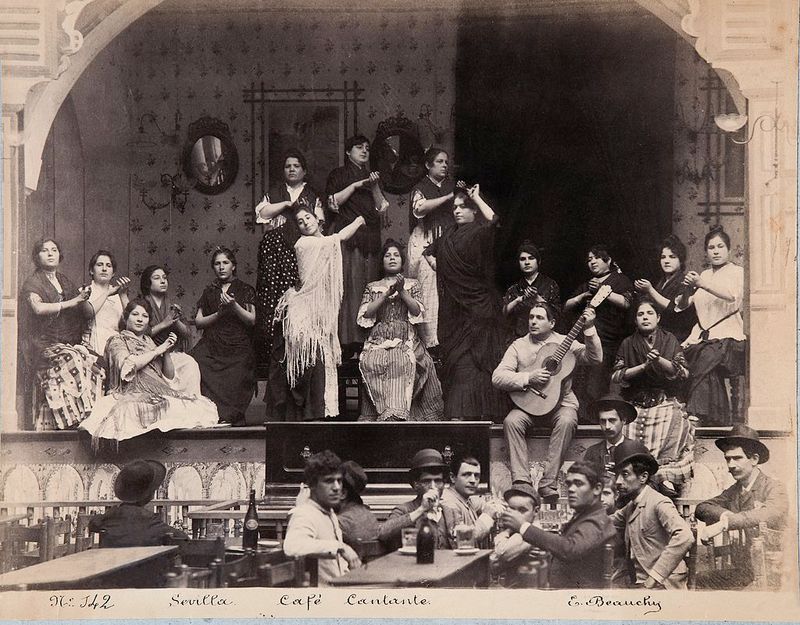


In this volume, we discuss the alphabet, definite and indefinite articles, and verbs ser and estar, among other topics.
Here is a list of five Spanish and Latin American popular music genres you should be familiar with:
Flamenco is a form of music that originated in the south of Spain. This rhythm-driven genre encompasses many different sub-genres that are native to the rich and diverse culture of Andalucía. Originally limited to cante, toque y baile (singing, guitar-playing, and dancing), and heavily rooted in both the joyful and percussive character of Castilian folk music and the lyrical and melancholic nuances of northern African chants, flamenco has evolved and incorporated a variety of elements from many traditional and not-so-traditional genres, including but not limited to rumba, jazz, Andean music, and Indian classical music.
Although flamenco is often associated with Andalucía and the gitanos (the Romani people in Spain), there are currently many renowned flamenco academies in several countries, and more and more music conservatories around the world are adding flamenco courses and ensembles to their traditional music departments, as the virtuosic nature of the toque and the complexity of the different rhythm patterns constantly attracts guitarists in particular and instrumentalists in general.
Two albums you must hear:
“Fuente y caudal”, by Paco de Lucía (1973)
“Se hace camino al andar”, by Enrique Morente (1975)
Moving away from the controversy surrounding the whos and hows regarding the usage of the term salsa (sauce, in Spanish) to refer to a musical genre for the first time, it is safe to say that salsa is the label that several musicians and record companies started widely using in the 1970s to market a mix of Cuban son, Puerto Rican bomba, and American jazz music and instrumentation, sprinkled with a vast variety of instrumental, melodic, rhythmic and aesthetic influences from the many Latin American countries from which several highly-talented artists had emigrated to settle, compose, arrange, record and perform in New York City.
Much water has flowed under the bridge since American lawyer Jerry Masucci and Dominican Republic-born musician Johnny Pacheco founded Fania Records in 1968; salsa music, still alive and well in the Big Apple, has also spread throughout the US, Latin America, Europe, Asia, Africa, and Oceania, to become a global phenomenon.
Two albums you must hear:
“Siembra”, by Rubén Blades and Willie Colón (1978)
“Comedia”, by Héctor Lavoe (1978)
As due to a lack of historical records the origins of tango are difficult to trace, we can consider artists such as Rosendo Mendizábal, El Choclo, Alfredo Gobbi, and Flora Gobbi among other members of the artistic movement that has come to be known as La Guardia Vieja as the precursors of the Argentinian and Uruguayan genre as we know it today.
Based on a simple and highly accentuated quadruple meter, and almost always featuring the nostalgic, airy sound of the bandoneón, tango music is often paired with poetically written lyrics that narrate stories of passion, crime, identity, and death.
Two albums you must hear:
“Libertango”, by Ástor Piazzola (1974)
“La máxima expresión del tango”, by Roberto Goyeneche (1964)
Characterized by its rippling, chorus-effected guitar lines, and its romantic subjects, this genre that originated and developed in the Dominican Republic throughout the 20th century can be widely heard in Latin music clubs and dance floors around the world today. From the early recordings of José Manuel Calderón in the 1960s to the hip-hop and R&B infused, highly elaborated, stadium-selling-out productions of Bronx-born and self-proclaimed King of Bachata Romeo Santos, this musical form has spread over very diverse audiences, mostly in the Spanish-speaking world, as it absorbed ideas, integrated elements, and drew inspiration from many different mainstream and avant-garde musical genres and urban cultural movements.
Two albums you must hear:
“Bachata Rosa”, by Juan Luis Guerra (1990)
“Fórmula, Vol. 1”, by Romeo Santos (2011)
Often carrying strong political content during the years of the Mexican Revolution and eventually evolving into a much more emotional style that frequently addresses love, grief, and patriotism, rancheras are often viewed more as a type of song than as a genre per se. Frequently performed by large conjuntos, but traditionally presented in a very intimate setting with only one or two acoustic guitars accompanying the singer and no additional instrumentation, many rancheras have become symbols of Mexican idiosyncrasy.
The term ranchera derives from the word rancho, as this musical form originated in the ranches and farms of countryside Mexico. Today, many Latin American, Spanish, and US-based interpreters often compose, record and perform songs in the ranchera style, often maintaining the heavily dramatic characteristic of the lyrics and the solemnity of the melodies and harmonies commonly associated with Mexican traditional music in general.
Two albums you must hear:
“La llorona”, by Chavela Vargas (1993)
“Las mañanitas”, by Pedro Infante (posthumous compilation, published in 1993)

Berges Institute is the fastest-growing Spanish language school for adults in the US, Europe, and India.
